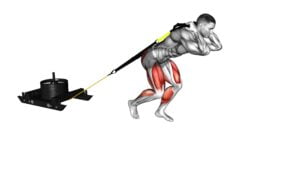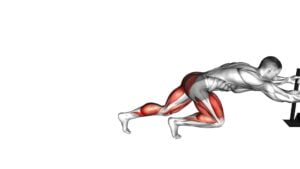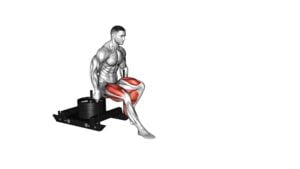Power Sled Rear Drag (VERSION 2) – Video Exercise Guide & Tips

Looking to take your workouts to the next level? Get ready to try the power sled rear drag. This intense exercise targets your lower body and builds strength and endurance.
Watch This Exercise Video
In this video exercise guide, you'll learn the proper form and technique, along with variations and progressions to keep challenging yourself. Avoid common mistakes and get tips for effective workouts.
Get ready to transform your fitness routine with the power sled rear drag.
Key Takeaways
- The Power Sled Rear Drag targets lower body muscles, builds strength and endurance, and improves speed and lower body strength.
- It engages quadriceps, hamstrings, glutes, and calves, while also activating core muscles for stability.
- Maintaining proper form and technique is important, including maintaining straight body alignment, focusing on breathing and relaxing the body, and engaging core muscles for stability and control.
- Muscle activation cues include pushing through the heels to engage glutes and hamstrings, keeping the core tight and maintaining a neutral spine, and modifying the exercise with lighter weight or knee/hip support if needed.
Benefits of the Power Sled Rear Drag
To maximize your workout, try incorporating the power sled rear drag for its ability to strengthen multiple muscle groups simultaneously. This exercise is highly beneficial for improving speed and increasing lower body strength.
The power sled rear drag primarily targets the muscles in your lower body, including your quadriceps, hamstrings, glutes, and calves. By dragging the sled behind you, you engage these muscles in a dynamic and challenging way, forcing them to work harder and become stronger.
Additionally, the power sled rear drag also activates your core muscles, as they're responsible for stabilizing your body during the exercise. Strengthening your lower body and core muscles through this exercise can have a significant impact on your athletic performance.
Whether you're a sprinter looking to improve your speed or an athlete aiming to enhance your overall lower body strength, incorporating the power sled rear drag into your workout routine can help you achieve your fitness goals. So, grab a sled and start dragging your way towards a stronger and faster you!
Proper Form and Technique
To ensure proper form and technique during the power sled rear drag exercise, there are several key points to keep in mind.
First, focus on maintaining a straight body alignment and good posture throughout the movement.
Activate the target muscles by using specific cues and engaging them properly.
Lastly, be aware of common form mistakes, such as rounding the back or pulling with the arms instead of the legs.
Body Alignment and Posture
Maintain optimal body alignment and posture to maximize the effectiveness of your Power Sled Rear Drag (VERSION 2) exercise. Proper form and technique are crucial for getting the most out of this exercise.
To start, focus on your breathing. Take deep breaths in and out, allowing your body to relax and oxygenate your muscles.
Engaging your core is equally important. Keep your abdominal muscles tight and your back straight throughout the movement. This not only helps protect your spine but also enhances the overall stability and control of the exercise.
Muscle Activation Cues
Focus on activating the appropriate muscles and maintaining proper form and technique during the Power Sled Rear Drag (VERSION 2) exercise to maximize its effectiveness and minimize the risk of injury. Here are some muscle activation cues and exercise modifications to help you perform this exercise correctly:
- Muscle activation cues:
- Engage your glutes and hamstrings by pushing through your heels during the drag.
- Keep your core tight and maintain a neutral spine to protect your lower back.
- Exercise modifications:
- If you're new to this exercise, start with a lighter weight on the sled and gradually increase the resistance as you get stronger.
- If you have knee or hip issues, consider performing the exercise on a softer surface or using a towel or pad under your knees for added support and cushioning.
Common Form Mistakes
Avoiding common form mistakes is crucial for maintaining proper form and technique during the Power Sled Rear Drag (VERSION 2) exercise. Improving performance and preventing injuries are two key benefits of executing this exercise correctly.
One common form mistake to watch out for is rounding your back. This can put unnecessary strain on your lower back and increase the risk of injury. To prevent this, focus on keeping your back straight and engaging your core throughout the movement.
Another mistake is gripping the sled handles too tightly. This can lead to excessive tension in your upper body and limit your ability to generate power from your lower body. Instead, aim for a relaxed grip that allows for fluid movement and optimal performance.
Variations and Progressions
Now let's talk about the variations and progressions you can incorporate into your power sled rear drag exercise.
By increasing the difficulty level, you can challenge yourself and continue to make progress.
You can also modify the exercise technique to target different muscle groups and add variety to your training routine.
Increasing Difficulty Level
To increase the difficulty level of the Power Sled Rear Drag (VERSION 2) exercise, you can incorporate various variations and progressions. Here are some ways to challenge yourself and take your workout to the next level:
- Increase the weight: Gradually add more weight to the sled to increase the resistance and intensity of the exercise.
- Decrease rest time: Shorten the rest periods between sets to keep your muscles engaged and maintain a higher level of intensity.
By progressing through different levels and incorporating advanced modifications, you can continuously challenge your body and ensure ongoing improvements in strength, power, and endurance.
Remember to listen to your body and progress at a pace that's appropriate for your fitness level. Keep pushing yourself and enjoy the rewards of your hard work!
Modifying Exercise Technique
Challenge yourself and take your Power Sled Rear Drag exercise to the next level by incorporating variations and progressions to modify your exercise technique.
Modifying the intensity of your Power Sled Rear Drag can help you target specific muscle groups and enhance the effectiveness of your workout.
To increase the intensity, you can add weight to the sled or increase the resistance by dragging it on a rougher surface. This will engage your muscles more and make the exercise more challenging.
Additionally, you can modify the exercise by changing the direction of the drag, such as moving sideways or in a zigzag pattern. This will activate different muscle groups and provide a more well-rounded workout.
Remember to listen to your body and gradually increase the intensity to avoid injury.
Common Mistakes to Avoid
Avoid falling into common mistakes when performing the Power Sled Rear Drag exercise by focusing on proper form and technique. Proper form is crucial to ensure you're getting the most out of this exercise and reducing the risk of injury. Here are some common mistakes to avoid:
- Rounding your back: Keep your back straight throughout the exercise to engage your core and protect your spine.
- Using your arms too much: Remember, this exercise is primarily focused on your legs and glutes. Avoid pulling the sled with your arms and instead, push with your legs to maximize the benefits.
- Leaning too far forward: While it's important to maintain a slight forward lean, avoid leaning too far forward as it can put excessive strain on your lower back. Keep a balanced posture throughout the movement.
- Not using enough resistance: The power sled is designed to challenge your muscles, so make sure you're using enough weight to provide adequate resistance. Start with a weight that allows you to maintain proper form, but still feel challenged.
By avoiding these common mistakes and focusing on proper form, you can ensure that you're getting the most out of your Power Sled Rear Drag exercise.
Now, let's move on to some tips for effective workouts.
Tips for Effective Workouts
Looking to maximize the effectiveness of your workouts with the Power Sled Rear Drag? Here are some tips to help you get the most out of your training sessions.
First, focus on increasing your workout intensity. The Power Sled Rear Drag is a challenging exercise that targets your lower body and engages multiple muscle groups. To make your workouts more effective, push yourself to work harder during each set. Increase the weight on the sled or try to complete the exercise in less time. By challenging yourself, you can increase the intensity of your workouts and stimulate greater muscle growth and strength gains.
In addition to intensity, it's also important to consider the duration of your workouts. While the Power Sled Rear Drag can be a demanding exercise, it's crucial to find a balance between pushing yourself and avoiding overtraining. Aim for a workout duration that allows you to complete your sets with proper form and without sacrificing intensity. Listen to your body and adjust the duration of your workouts accordingly.
Sample Power Sled Rear Drag Workout Plan
To create an effective power sled rear drag workout plan, prioritize incorporating progressive overload and focusing on compound movements. Progressive overload means gradually increasing the intensity, duration, or frequency of your workouts to continue challenging your muscles and promoting growth. Compound movements, such as squats, lunges, and deadlifts, engage multiple muscle groups simultaneously, maximizing the efficiency of your training.
Here is a sample power sled workout plan to help you get started:
- Warm up with dynamic stretches and mobility exercises to prepare your muscles for the workout.
- Perform power sled rear drags for 3 sets of 10-12 repetitions, focusing on maintaining proper form and control throughout the exercise.
- Incorporate other compound movements like squats, lunges, and deadlifts into your workout routine. Aim for 3-4 sets of 8-10 repetitions for each exercise.
- Rest for 60-90 seconds between sets to allow for recovery and proper muscle activation.
- Finish your workout with a cool-down period that includes static stretching to help reduce muscle soreness and improve flexibility.
Tips for using the power sled effectively:
- Start with lighter weights and gradually increase the resistance as your strength and endurance improve.
- Engage your core muscles and maintain a stable posture throughout the exercise to maximize the benefits.
- Focus on pushing through your heels and driving the sled backward, using your glutes and leg muscles for power.
- Maintain a steady pace and avoid jerky movements to minimize the risk of injury.
Frequently Asked Questions
How Much Weight Should I Start With When Doing the Power Sled Rear Drag Exercise?
When starting the power sled rear drag exercise, it's important to consider your starting weight. Begin with a weight that challenges you but allows you to maintain proper form and technique.
As you progress, gradually increase the weight to continue challenging your muscles. The key is to find a progression rate that works for you, gradually increasing the weight over time to avoid injury and maximize strength gains.
Can the Power Sled Rear Drag Exercise Help Improve My Speed and Agility?
The power sled rear drag exercise is a great way to improve your speed and agility. Athletes can benefit from this exercise by increasing their power and explosiveness.
It targets the muscles in your legs, hips, and core, helping you build strength and stability.
The exercise can be modified to suit different fitness levels by adjusting the weight on the sled or the distance of the drag.
Incorporating this exercise into your training routine can help you take your performance to the next level.
Is It Better to Perform the Power Sled Rear Drag Exercise on Grass or a Hard Surface?
To answer your question about whether it's better to perform the power sled rear drag exercise on grass or a hard surface, it depends on your goals.
Performing this exercise on grass can provide more resistance and challenge your muscles, improving muscle building.
On the other hand, performing it on a hard surface can help improve speed and agility by focusing on the explosiveness of your movements.
Consider your specific fitness goals and choose the surface that aligns best with them.
Can I Incorporate the Power Sled Rear Drag Exercise Into My Regular Running Routine?
Yes, you can definitely incorporate the power sled rear drag exercise into your regular running routine.
This exercise adds resistance to your running, which helps to improve your lower body strength and power.
Running with a power sled engages your glutes, hamstrings, and quads, making them stronger and more efficient.
The benefits of the power sled rear drag include increased speed, endurance, and explosive power.
How Often Should I Do the Power Sled Rear Drag Exercise to See Results?
To see results from the power sled rear drag exercise, you may be wondering how often is too often to do it. Well, it depends on your fitness level and goals. Generally, it's recommended to incorporate this exercise 2-3 times a week into your routine.
Consistency is key, but remember to listen to your body and give yourself enough time to recover between sessions. Results can vary, but with regular training, you may start noticing improvements within a few weeks.
Conclusion
In conclusion, the Power Sled Rear Drag is a highly beneficial exercise that targets the muscles of the lower body and improves overall strength and power.
By maintaining proper form and technique, varying the intensity and resistance, and avoiding common mistakes, you can effectively incorporate this exercise into your workout routine.
Remember to start with lighter weights and gradually increase the load as your strength improves.
Follow the sample workout plan provided to maximize the benefits of the Power Sled Rear Drag.

Author
Years ago, the spark of my life’s passion ignited in my mind the moment I stepped into the local gym for the first time. The inaugural bead of perspiration, the initial endeavor, the very first surge of endorphins, and a sense of pride that washed over me post-workout marked the beginning of my deep-seated interest in strength sports, fitness, and sports nutrition. This very curiosity blossomed rapidly into a profound fascination, propelling me to earn a Master’s degree in Physical Education from the Academy of Physical Education in Krakow, followed by a Sports Manager diploma from the Jagiellonian University. My journey of growth led me to gain more specialized qualifications, such as being a certified personal trainer with a focus on sports dietetics, a lifeguard, and an instructor for wellness and corrective gymnastics. Theoretical knowledge paired seamlessly with practical experience, reinforcing my belief that the transformation of individuals under my guidance was also a reflection of my personal growth. This belief holds true even today. Each day, I strive to push the boundaries and explore new realms. These realms gently elevate me to greater heights. The unique combination of passion for my field and the continuous quest for growth fuels my drive to break new ground.







